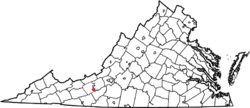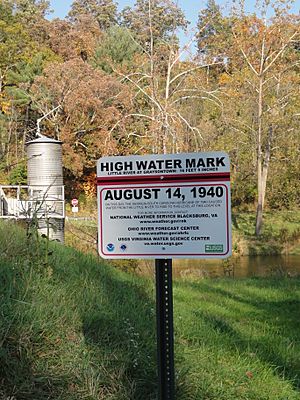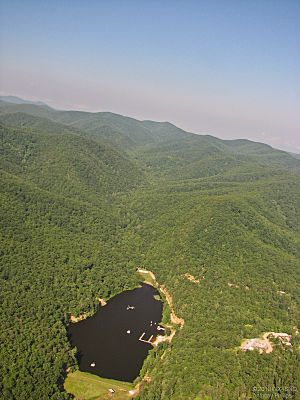Snowville, Virginia facts for kids
Quick facts for kids
Snowville, Virginia
|
|
|---|---|
|
Census-designated place (CDP)
|
|

The community of Snowville along the Little River
|
|

Location of Snowville, Virginia
|
|
| Country | United States |
| State | Virginia |
| County | Pulaski |
| Elevation | 1,940 ft (591 m) |
| Population
(2010)
|
|
| • Total | 149 |
| • Density | 66.2/sq mi (5.9/km2) |
| Time zone | UTC−5 (Eastern (EST)) |
| • Summer (DST) | UTC−4 (EDT) |
| ZIP code |
24347
|
| Area code(s) | 540 |
Snowville is a small community in Pulaski County, Virginia. It is called a census-designated place (CDP). This means it is a special area defined for collecting population data. In 2010, about 149 people lived there. Snowville is part of the larger Blacksburg–Christiansburg Metropolitan Statistical Area.
Contents
Geography and Climate in Snowville
Snowville is located along the Little River. This river forms the border between Pulaski County and Montgomery County. The community sits within the beautiful Blue Ridge Mountains. These mountains are part of the larger Appalachian Mountain Range. High Knoll Mountain and Bench Mountain are found to the south of Snowville. To the north, you'll find Claytor Lake.
Understanding Snowville's Weather
Snowville has a temperate climate. This means it has four distinct seasons. In winter, temperatures usually range from 30 to 40 degrees Fahrenheit. Summer temperatures are typically in the 70s and 80s. Snowfall in winter can be between 12 and 24 inches.
Spring can bring flash floods from mountain runoff. In the fall, tropical storms sometimes cause heavy rain and strong winds. For example, Hurricane Hugo in 1989 caused damage. Experts at Virginia Tech and the National Weather Service study flood risks here. They use geographic information systems (GIS) to help predict flooding. Very hot or very cold temperatures are rare but have happened.
Historic Flooding Events in Snowville
The worst river flooding in Snowville's history happened on August 14, 1940. A slow-moving tropical storm caused this event. This storm started near the Leeward Islands in the West Indies. It moved northwest, bringing strong winds to places like San Juan, Puerto Rico.
The storm became a hurricane and hit Beaufort, South Carolina on August 11. As it moved inland, it brought record rainfall to South Carolina and Virginia. The mountainous area of Floyd County, Virginia received over 17 inches of rain.

The United States Geological Survey (USGS) has a stream gauge at the Snowville bridge. During the 1940 flood, the Little River reached a record height of 16 feet 5 inches. This was more than 15 feet higher than normal. Downstream in Radford, Virginia, people had to leave their homes. Factories also closed due to high water. Luckily, no one died in southwest Virginia, but there was a lot of damage.
On October 18, 2011, a sign was put up to remember this historic flood. It is located along the Little River at the Graysontown-Snowville bridge. A local expert, Anthony Phillips, donated the sign. The National Weather Service and the United States Geological Survey supported its installation. This project helps people learn about flood risks.
More recently, in 2004, Hurricane Jeanne caused flooding. The Little River reached 11 feet 4 inches, which was the ninth-highest flood ever recorded.
People and Population in Snowville
Snowville does not have its own post office or zip code today. This means there are no separate population statistics just for Snowville. The information below includes Snowville as part of the "Greater Hiwassee-Snowville community."
Who Lives in the Snowville Area?
According to the United States Census Bureau in 2000, 1,865 people lived in the Greater Hiwassee-Snowville community. There were 757 homes and 576 families. Most residents (97.4%) were White. About 1.8% were African American. A small number were Native American or from other backgrounds. About 0.3% of the population was Hispanic or Latino.
Age and Income in the Community
In 2000, 18.7% of residents were under 15 years old. About 19.8% were older than 59. The average age was 40.4 years. There were slightly more males (50.3%) than females (49.7%).
The average income for a household was $32,950. For families, it was $42,188. About 9.4% of families lived below the poverty line.
Most people (84.3%) drove alone to work. About 12.7% carpooled. Only 3.0% walked to work. Most working residents (87.0%) were employed by private companies. About 11.4% worked for the government.
The Early History of Snowville
Today, Snowville is a quiet community in the Blue Ridge Mountains. But long ago, it was a busy and well-known town. It was even more important than Roanoke at one point.
How Snowville Was Founded
In the early 1800s, a cabinet maker named Asiel Snow moved to Christiansburg, Virginia. He was delivering a cabinet when he saw the Little River. He realized the river could power mills and factories. He imagined a town growing there. In 1833, he moved his family to this area. The town was later named "Snowville" after him.
The community was first called "The Foundry" on August 13, 1850. Then, on November 18, 1850, it was renamed "Humility." Finally, on March 31, 1854, it officially became "Snowville."
Many of Snow's friends and their families also moved to the area. These included the Slenkers, Bullards, and Bills. Other families from nearby areas also settled there. These families had different skills. Some were good with textiles, others were merchants. There were also millwrights, carpenters, tanners, and shoemakers. This mix of skilled people helped Snowville grow into a successful town.
Industry and Business in Early Snowville
The mountains around Snowville had a lot of iron ore. One of the first factories was a trip-hammer forge. It was located where Little Laurel and Big Laurel creeks meet. Asiel Snow and his son-in-law, David B. Bill, ran it. They made products from cast and wrought iron. These included stoves, kettles, and tools for farms. Wrought iron was used for horseshoes, buggies, and parts for sawmills.
Later, the forge moved to Snowville, next to a three-story building. The first floor made linseed oil from flax seed. The second floor was a sawmill, cutting lumber for new buildings. The third floor was a mill that turned wool into clothing.
An important woolen mill started just before the Civil War. Isaac Slenker finished it after the war. This mill changed Snowville's social life. People from all over brought their wool to be made into jeans and blankets. This helped Snowville connect with the outside world.
On the west side of town, W. S. Bullard ran a tannery. Tanning is the process of making leather from animal skins. You can still see the old tanning pits along Route 693 today.
Another big factory was the shoe factory along the Little River. It was called the Red Barn because of its color. This factory made many shoes and boots. They were sold across Virginia and other Mid-Atlantic states.
Other factories and shops also existed. During the Civil War, swords and Bowie knives were made for the Confederate Army. Joe Craft had a barrel factory. He made barrels for whiskey and flour, and wooden washtubs. People also brought eggs to Snowville. They were packed in barrels and sent to big cities. Another building made pillows from bird feathers.
Historically, some people in Snowville made their own alcoholic drinks. Two known stills operated in the mid-1800s. Later, in the 20th century, a larger operation existed near Buck Hollow Ridge.
Postal Service in Snowville's Past
In early Snowville, Postal mail was not delivered every day. It usually came once or twice a week from Christiansburg. A post rider on horseback or mule brought it. The first post office opened on August 13, 1850.
Here are some of the people who served as postmasters and when they started:
| Postmaster | Appointment Date | Township |
|---|---|---|
| Chester Bullard | August 13, 1850 | The Foundry |
| Reuben J. Ruke | March 11, 1852 | Humility |
| Chester Bullard | March 25, 1854 | Humility |
| Stillman B. Snow | March 31, 1854 | Snowville |
| John Carmical | December 31, 1857 | Snowville |
| William T. Shelor | November 4, 1858 | Snowville |
| Joseph H. Winston | January 29, 1866 | Snowville |
| William H. Smith | May 27, 1872 | Snowville |
| Joseph H. Covey | May 3, 1881 | Snowville |
| Joseph H. Winston | September 25, 1883 | Snowville |
| James W. Bocock | July 20, 1885 | Snowville |
| David J. Showalter | June 10, 1889 | Snowville |
| William Showalter | October 28, 1890 | Snowville |
| Clifton E. Elmore | October 27, 1893 | Snowville |
| Genetho S. Hall | July 6, 1897 | Snowville |
| Thomas H. Elmore | April 4, 1914 | Snowville |
| Lonnie C. Elmore | October 1, 1949 | Snowville |
| Miss Martha J. Bill | May 16, 1950 | Snowville |
The Snowville post office closed in the late 1900s. Today, residents get their mail through the Hiwassee post office.
Religion in Snowville's History
In 1870, the first official church building was built in Snowville. It was called Snowville Christian Church. Asiel Snow led its establishment. The church had a large balcony. A big bell was donated by Miss Mary Snow. It rang for the first time to announce her death. When someone died, the bell would tap three times. Then, it would ring once for each year of the person's life. The Snowville bell was known for its unique sound. It could be heard 7 miles away in Auburn.
Snowville was often called the Jerusalem of the Southwest. This was because of its strong ties to the Christian Church (Disciples of Christ). Many saw it as the center of this church's movement in Virginia. Dr. Chester Bullard, Asiel Snow's brother-in-law, helped start many churches.
A cemetery and a cave were named after Dr. Bullard. He preferred to be buried above ground. He used a cave along the Little River for his family members. Unconfirmed reports say four bodies were later moved to Snowville Cemetery. Dr. Bullard's grave is in Bullard Cemetery.
Many important ministers came from the historic Snowville Church. These included J. T. Showalter and W. S. Bullard.
The church had some disagreements over the years. During the Civil War, there was a debate about secession. Later, there was a discussion about using organs and other musical instruments in church. Today, music from Snowville Christian Church can be heard for miles.
Early Education in Snowville
Education in Snowville started with private schools. These were often held in people's homes. In 1858, the first public school opened. It was in a building that used to be a woolen mill. Later, the school moved to another building on a hillside.
Schools were mostly supported by donations. Students above the fourth grade paid $2.50 tuition each month.
In 1884, the Pulaski County School Board built a new three-room schoolhouse. It had a four-year high school and a seven-year elementary school. Some classes were also held in an old store building. Students from far away would come to Snowville to live and study. At one time, Snowville almost had a junior college. However, around 1922, fewer students enrolled. Snowville High School then offered only two years of education. Later, high school students went to Draper for school.
Other Interesting Facts About Snowville
- In winter, residents used to enjoy skating on the Little River when it froze. Today, the river rarely gets cold enough to freeze.
- The Library Association of Snowville was very large around 1890. Ed Howery led it.
- The Masonic Lodge No. 159 in Snowville is one of the oldest in the region. It was started on December 13, 1865.
- The first newspaper in Snowville was called The Virginia People. When it stopped, its printing equipment moved to Christiansburg.
- Snowville never had a saloon or bar. People got alcohol from other sources.
- About 13,000 soldiers marched through Snowville during the Civil War. It took them half a day to pass through town.
- Fox hunting was a popular sport in early Snowville.
- The Snowville Historic District was added to the National Register of Historic Places in 1987.
Why Snowville Declined
After the Civil War, Snowville began to decline. The biggest reason was the railroad. It was built to bypass Snowville, going through Christiansburg and Radford instead. People started leaving Snowville to find work in these new railroad towns.
Snowville Today
Today, Snowville is a quiet community where life moves at a slower pace. Residents enjoy a simpler way of life away from busy towns. However, most people work in nearby areas or on local farms. The Radford Foundry used to employ many residents. It closed in 2003, causing many job losses. The Radford Army Ammunition Plant and other factories in the New River Valley (NRV) now employ people from Snowville.
As mentioned, the Snowville Post Office closed. Residents now get their mail from the Hiwassee post office.
Education for Students in Snowville Today
Younger students (grades K-5) attend Snowville Elementary School. Middle school students go to Dublin Middle School] in Dublin. High school students attend Pulaski County High School, also in Dublin. For higher education, students often go to New River Community College, Radford University, or Virginia Tech.
Snowville is also home to Camp Ottari. This is a Boy Scout camp. Camp Ottari and Camp Powhatan are part of the Blue Ridge Scout Reservation. This reservation covers over 16,000 acres of mountain land.

See also
 In Spanish: Snowville (Virginia) para niños
In Spanish: Snowville (Virginia) para niños





